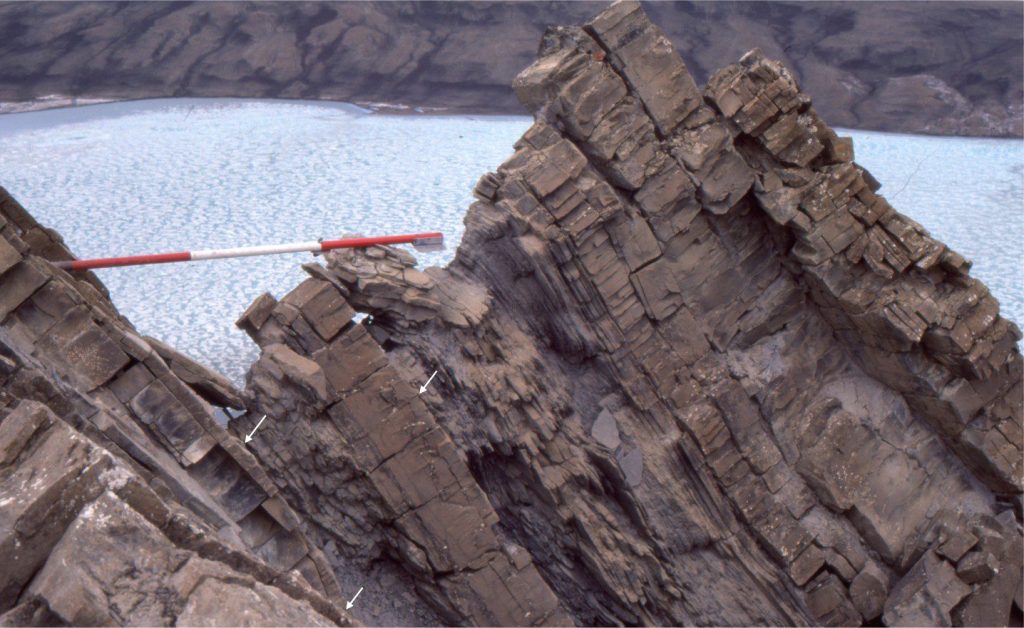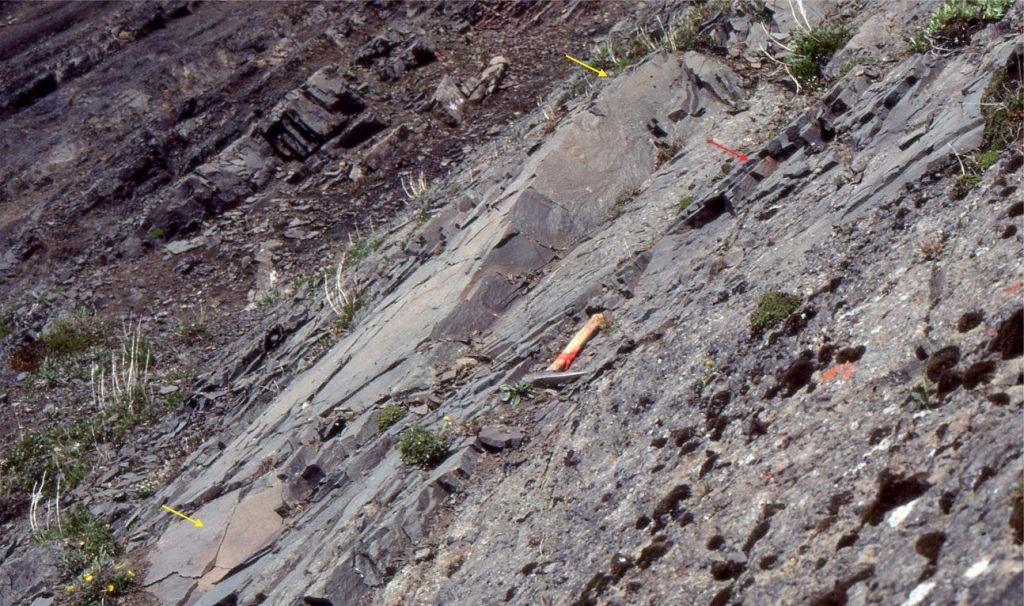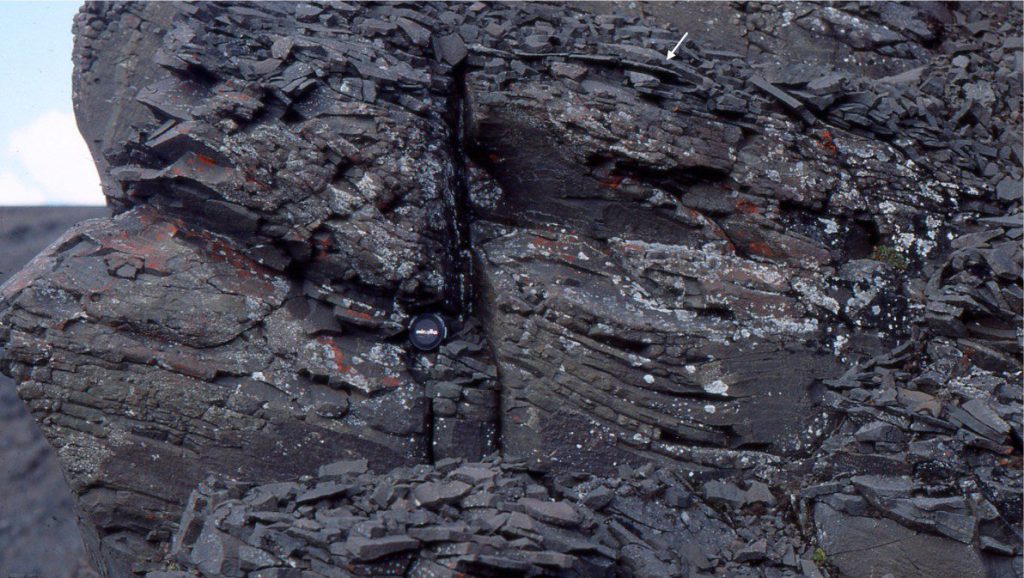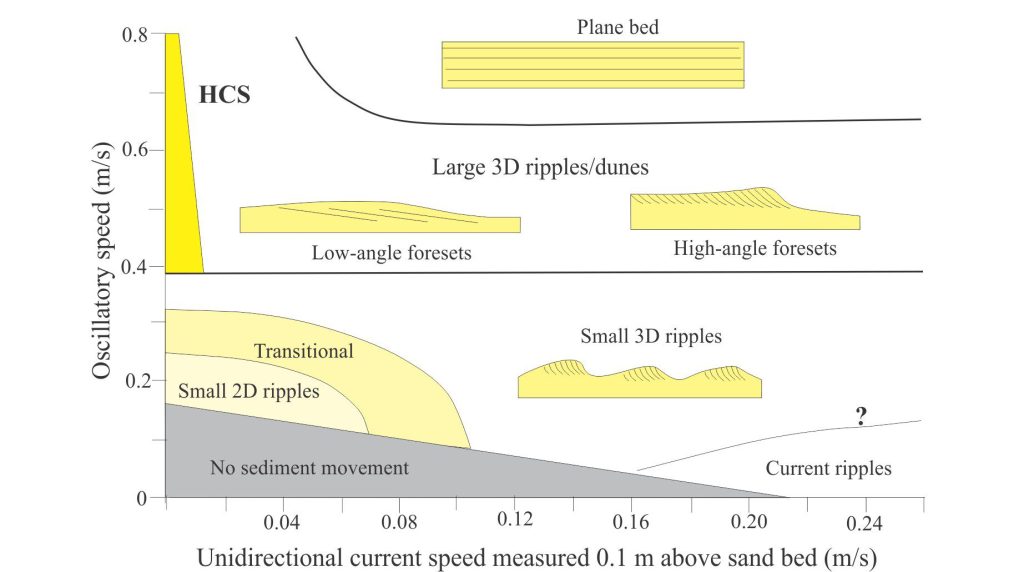
HCS and SCS – useful paleobathymetric indicators
Use this link to read the introduction to the lithofacies series.
General occurrence
Hummocky cross-stratification and its close cousin swaley bedding (SCS) are two bedforms that offer sedimentologists a modicum of hope in their search for paleoenvironmental indicators. HCS (the commonly used acronym) forms on the lower shoreface – shelf during storms where wave orbitals combine with bottom-hugging flows to mould 3D bedforms. Thus, the presence of HCS in the rock record provides a reasonably reliable paleobathymetric indicator, forming somewhere between fairweather wave-base and storm wave-base.
External structure
HCS and SCS are conjoined bedforms; the hummocks are low amplitude mounds and the adjacent swales dish-shaped depressions. Both are approximately equidimensional to slightly asymmetric in map view. They are three-dimensional bedforms that require at least two cross-sectional profiles to describe their geometry. Hummock and swale amplitudes are measured in centimetres. The separation of hummocks, measured between mound apices, usually ranges from 10s of centimetres to 5-6 m. The hummocks differ from most other 3D bedforms in that there are no lee or stoss faces.
Parting lineation is common on exposed hummock surfaces.

Internal structure

HCS and SCS are found in sharp-based, fine- to medium-grained sandstone beds. In cross-section, sandstone laminae a few millimetres thick conform to the mound or swaley surfaces – i.e., they are continuous from trough to apex, and again to trough. Swaley bedding is concave upward. Individual laminae may thicken towards the troughs. The locus of lamina accretion is approximately vertical, conforming to the 3D surface expression of the mounds and swales. However, the mounds are not always symmetrical; cross-sections through many ancient HCS examples show some degree of lamination asymmetry. Truncations between successive sets of hummocks and swales are low-angle, commonly 10o to 15o. Some stratigraphic sections contain mostly SCS without the accompanying HCS.
The thickness of HCS-SCS bearing strata ranges from a few centimetres to 10s of metres. HCS-SCS sandstone units are usually interbedded with mudrocks. They may also overlie thin graded sandstone beds, and less commonly thin pebbly mudstones.

Formation – hydrodynamic behaviour
It is generally accepted that HCS-SCS are the depositional response to the passage of storm waves across the deeper parts of shelves and platforms, although there is still no consensus on their formation. Storm waves are higher amplitude and longer period than fairweather waves, and therefore the oscillatory motion of their orbitals will interact with deeper water substrates. However, based on theoretical considerations of wave dynamics and HCS geometry, P.A. Allen (1985) opined that wave motion cannot be the sole depositional agent; the implication here is that bottom-hugging currents must also be involved. Not everyone agrees with this conclusion.
One of the earliest experiments on HCS was conducted in a flume-like tunnel, where it was possible to introduce both oscillatory and unidirectional flow over a sand bed (Arnott and Southard, 1990). Low relief, HCS-like mounds were generated when oscillatory flow alone was applied. However, when a unidirectional current was added, even at low velocities, the HCS mounds became asymmetrical with slightly steeper faces downstream. With increasing velocity, the HCS bedforms were replaced progressively by ripples and larger 2D dunes. Thus, from an experimental perspective, both oscillatory and combined flow hypotheses are feasible.

The involvement of unidirectional bottom currents has since been verified from observations of recent storms on Atlantic and North Sea shelves. The jury is still deliberating on the exact mechanism, or mechanisms of HCS-SCS formation.
If bottom currents are involved, what kind of flows can we invoke?
Tidal currents (i.e., diurnal or semidiurnal) are always present, constantly interact with the substrate above fairweather wave-base, but do not produce HCS-like structures. Furthermore, they are bidirectional over the average life of a storm.
During major storms, water masses are pushed landward such that there is a temporary and local rise in sea level. Several authors have postulated that the subsequent storm surge ebb can generate seaward-directed, shore-normal turbidity currents (e.g., Hamblin and Walker, 1979). Perhaps these turbulent, high suspension-load flows combine with the wave-generated oscillatory flow to build HCS.
Based on paleocurrent evidence from HCS-bearing strata and associated turbidites (e.g., flute and groove casts, parting lineations), Leckie and Kristinik (1989) concluded that the turbidity currents have a significant component of shore-normal flow and that HCS forms under conditions where both density current and wave orbital flows combine. However, storm generated shore-parallel, or isobath-parallel flows have also been reported from the modern North American Atlantic shelf by Swift et al., 1983. Such flows are called geostrophic flows – flows that are deflected by Coriolis forces. The lower flow boundary of these geostrophic currents is turbulent and contains a high suspended sediment load (Duke et al., 1991)(PDF available). Thus, under certain conditions HCS-SCS can also be generated by a combination of shore-directed oscillatory flow and along-shore geostrophic currents that form in response to downwelling storm surges (Duke et al., 1991). Deposition of laminae occurs as the flows lose momentum such that sediment falls from suspension and is subsequently moulded by the oscillatory flow.
Common environments
By far the most common record of hummocky and swaley cross stratification is in shelf-platform successions. They tend to occur in the lower parts of shallowing-upward (and usually coarsening upward) parasequence-scale successions. Associated shoreface lithofacies include bedforms typical of shoreface environments (e.g., 2D and 3D crossbeds), indicators of tidal reversals, invertebrate and trace fossil assemblages, and mineralogical indicators such as ooids, glauconite, and marine carbonate cements.
HCS is generally found below fairweather wave-base in part because mounds are positive structures on the sea floor that at shallower depths are prone to reworking; its preservation potential above fairweather wave-base is significantly lower than at storm wave-base. SCS on the other hand accumulates in troughs, such that their preservation may extend to shallower depths across the shoreface.
Other posts in this series
Sedimentary lithofacies – An introduction
Ripple lithofacies: Ubiquitous bedforms
Ripple lithofacies influenced by tides
Tabular and trough crossbed lithofacies
Laminated sandstone lithofacies
Low-angle crossbedded sandstone
Lithofacies beyond supercritical antidunes

















